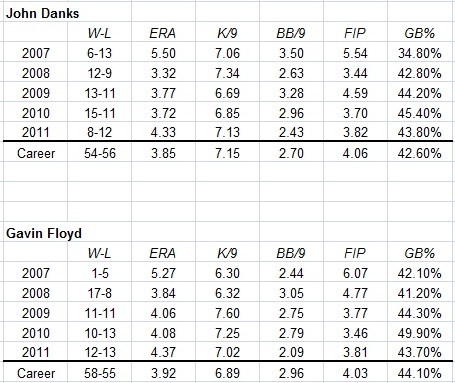On Tuesday Jim Salisbury of CSNPhilly.com reported that the Phillies and Cole Hamels were not likely to reach a long-term extension before the start of the season and were more focused on inking Hamels to a one-year deal in 2012, which represents his final year of arbitration eligibility and team control. While assistant general manager Scott Proefrock insisted that there is plenty of time to reach a deal at a later date, this admission represented the strongest possibility yet that Hamels would reach free agency after the 2012 season and hit the open market as the best left-handed pitcher, if not best overall pitcher, available. Salisbury mentioned that Jered Weaver’s five-year, $85M extension with the Angels would be a reasonable comparable for the Phillies and Hamels, but Hamels may have something far more lucrative and long-term in mind.
A lot of digital ink has been spilled and a lot of hands have been wrung lately over the Yankees insistence on watching their payroll. At this point, no one knows whether they’re serious about a long-term reduction in payroll towards a $189M target, or whether they simply have disliked the prices on the free agent market thus far. In the past, the Yankees have always shown a willingness to pay a premium for what they deem to be premium talent. Alex Rodriguez, CC Sabathia, Mark Teixeira and A.J. Burnett are all beneficiaries of this approach, and Cliff Lee could easily have joined them. The operative turn of phrase though is “what they deem to be premium talent”. Their approach towards middle-of-the-road talent is far more mixed. The team has been slow this offseason to pursue current available pitchers Hiroki Kuroda, Roy Oswalt and Edwin Jackson, and they avoided spending $80 or $100M on C.J. Wilson and Yu Darvish, respectively. Is this because they want to reduce payroll, or is it because they don’t deem them to be premium talent and want to keep their powder dry for bigger targets? No one seems to know.
If they’re keeping their powder dry for bigger targets, it would make sense why they haven’t been so eager to snap up one of the currently available pitchers. It would also explain their interest in a one-year deal with one of Kuroda or Oswalt, provided the salaries drop. It doesn’t mean that they’re cheap; it means they’re serious about getting good value for their dollars (A.J. Burnett laughs) and saving room for the players they deem to be truly worth a nine-figure investment. This is where Cole Hamels (or Zack Greinke or Matt Cain, if you prefer), come in. As pitchers go, Hamels would likely be the third best starting pitcher to hit the free agent market in the last decade, behind CC Sabathia and Cliff Lee. As Joe noted to me, one Hamels will actually hit the market with a better track record than Cliff Lee. He would end the Yankees pursuit of a number two starter behind Sabathia. In fact, his career performance really makes him worthy of the title of co-ace with CC: 8.45 K/9, 2.26 BB/9, 1.09 HR/9 and a 3.39 ERA. If you’re going to spend on premium talent, Cole Hamels is at the top of the list.
As the Yankees dance with Kuroda, Oswalt and Jackson over the next few weeks, it’s important to keep the long game in mind. If the team has no intention of moving the payroll permanently to the $225M+ range, then fans should root for them to preserve long-term payroll flexibility over the next ten months until Hamels becomes available. In fact, Joel Sherman noted that they appear to be doing just that and will be pursuing one year deals and one year deals only. If Kuroda or Oswalt can fit into this year’s budget as the team looks towards next winter’s bonanza, then great. If they sign elsewhere for $12M per year (an amount which would actually represent close to $16M to the Yankees with the luxury tax added in), then the team can make due with what they have now and retain the ability to add payroll in July or August via trade. Someone like Greinke or Cain could become available, or someone entirely unexpected such as Ubaldo Jimenez this past season. Regardless, there remains reason to be cautiously optimistic that this team’s rotation could see a temporary improvement this year and a serious long-term improvement next winter.
